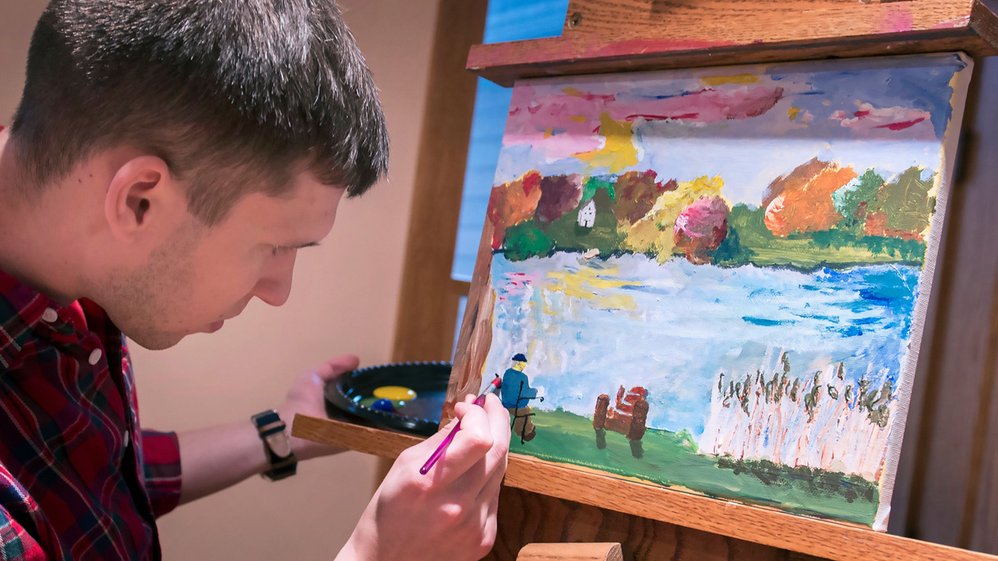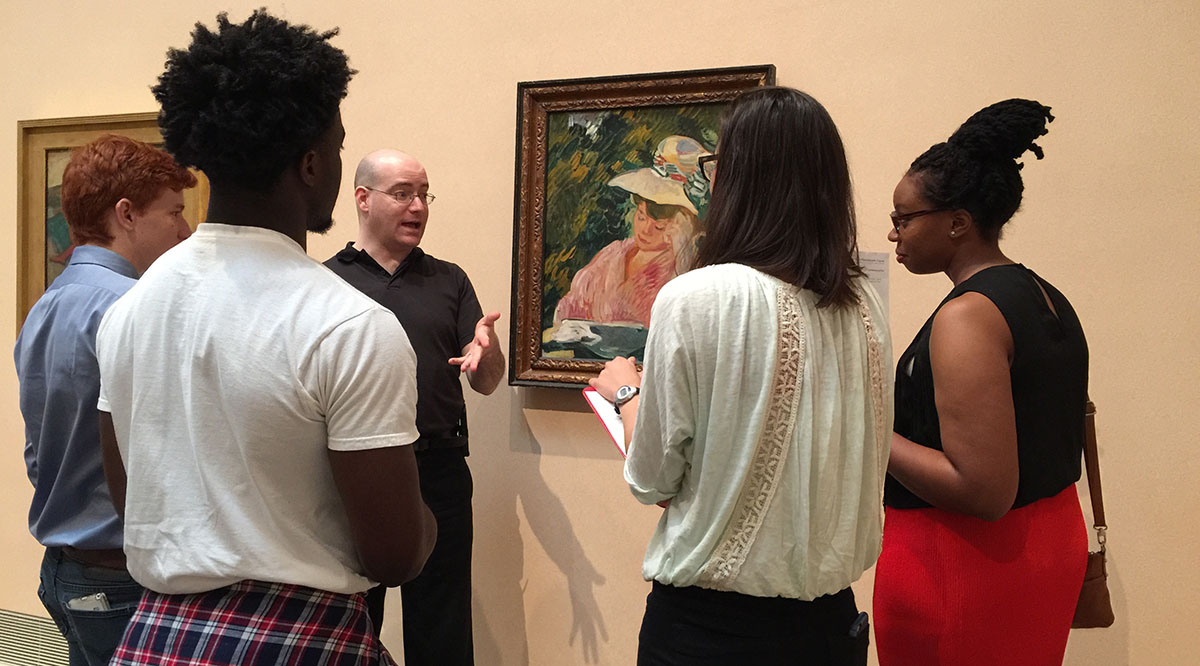
When Paul Haidet, MD, MPH, talks with doctors and medical students about conversational strategies they can adopt to better understand their patients, “the pushback that always comes out of the audience is, ‘We get this patient-centered stuff, but you have to understand: We have no time.’”
For Haidet, the key is less about time and more about listening keenly and improvising responses that build on what patients say, like one jazz player riffing off the play of another. That’s why he, a disc jockey who grew up to become a professor at the Penn State College of Medicine (PSCM), created Jazz and the Art of Medicine — a course that uses jazz to teach students improvisational communication skills.
The class illustrates one of the many ways that colleges and universities integrate arts and humanities into medical education. Other such initiatives include inviting students to learn by dancing with Parkinson’s disease patients, studying documentaries about underserved populations, writing the life stories of military veterans, and acting out scripts about medical ethics in front of community audiences.
Those are among the activities cited in a new AAMC report, The Fundamental Role of the Arts and Humanities in Medical Education, which finds that “the vast majority of U.S. medical schools have incorporated arts and humanities to varying degrees,” but that the potential impact of the activities is unfulfilled because of significant variation in the content, curricula integration, teaching methods, and evaluation methods. The report recommends ways to better integrate arts and humanities throughout the curricula and to better assess their value.
“The arts and the humanities can play a unique and unrealized role in preparing and equipping physicians for 21st-century challenges,” says the report, which was produced by committees composed of educators, clinicians, researchers, historians, humanities scholars, artists, and communication experts. “The integration of the arts and humanities into medicine and medical education is essential to educating a physician workforce that can effectively contribute to optimal health care outcomes for patients and communities.”
The publication — part of the AAMC’s Fundamental Role of the Arts and Humanities in Medical Education initiative — cites four functions of arts and humanities in strengthening the education of medical students and physicians:
- Mastering skills — improving clinical care abilities like case presentation and critical thinking.
- Taking perspective — bringing to light the “sometimes contradictory perspectives” of patients and others involved in clinical encounters.
- Personal insight — fostering reflection about inward processes and struggles, which contribute to self-identity, emotional growth, wellness, and resilience.
- Social advocacy — inciting learners to critique and transform norms, as well as potential inequities and injustices in health care.
Integration challenges
Colleges and universities weave arts and humanities into medical education in many ways, the report explains, such as by offering electives, adding special sessions to regular courses, and fully integrating opportunities throughout rotations and programs so that all students get the experiences.

However, it notes that arts and humanities face perceptual barriers, such as a belief among many educators that there’s no room in the curricula for content not based on hard science and a skepticism that arts and humanities experiences can be shown to improve someone’s medical education.
“The evidence that directly links arts and humanities integration with medical education learning outcomes is limited,” the report says. “Indeed, causality is difficult to prove for most educational activities designed to support the complex process of learning to be a physician.”
“We need to think more inclusively and expansively about the ways we approach that research,” says Lisa Howley, the AAMC’s senior director of strategic initiatives and partnerships. While standard evaluations of medical education are based on quantitative assessments of progress on scientific knowledge, she says that “to understand the impacts of the arts and humanities on education, we need to move toward more robust, mixed methods of research and evaluation, including qualitative research.”
Enhancing research and evaluation methods is one of nine recommendations in the report. Others include providing more professional development to help faculty design curricula and implement models that integrate the arts, humanities, and medicine; more tightly linking the arts and humanities offerings to core physician competencies; and increasing collaboration in curricula design among faculty, learners, patients, and arts and humanities partners.
Below are examples of how programs cited in the report integrate arts and humanities and attempt to address the challenges.
Jazz at Penn State
The Jazz and the Art of Medicine course at the PSCM is offered as a four-week elective each fall to senior-level students, Haidet says. They listen to jazz — he says the “text” for the course is the Miles Davis album Kind of Blue — paying particular attention to how the musicians accompanying the lead player listen and respond in ways that build on what the lead communicates.
The idea is to contrast the fine-tuned responses that make each rendition of a jazz performance unique to the more conventional conversations that medical students and physicians typically have with patients. “Docs and students are typically three questions ahead when they’re listening, which means they’re not really listening,” he says.
“We talk about listening for meaning — how to have a true conversation.”
The students analyze how to apply aspects of jazz improvisation to their patient conversations and then practice those techniques during clinical visits. According to Haidet, that allows students not only to try more thoughtful listening and response skills with real patients, but also to do so under the time pressure of seeing numerous patients during their regular shifts.
The students write reflections about the conversations, which Haidet says helps them ponder, “How do I come across? How do I play to my strengths?”
“It opens a huge conversation about professional identify formation,” he explains.
By the end of the course, each student creates a plan to practice conversational skills through their education and into their careers, helping to build their communication style as caregivers.
A study of 30 students compared to a control group, published by Haidet and others in 2017, showed “statistically significant and educationally meaningful gains in adaptability and listening behaviors.”
Storytelling at Veterans Affairs (VA) hospitals
At the VA Boston Healthcare System (VABHS), medical students, residents, physician assistant students, and learners in other health professions talk with military veterans to craft a first-person narrative of each one’s life story. The aim of the My Life, My Story program, the report says, is to “bring each veteran’s story to the forefront of their care” and enhance learners’ competence in patient-centered care by teaching them how to get to know the full person.
The stories, about 1,000 words each, are entered into the patients’ electronic medical records (with permission) so that other caregivers can know the patient better, says Susan Nathan, MD, site director for My Life, My Story at the VABHS. (The program runs at dozens of other VA medical centers with varying degrees of student participation.)
Integrating this activity into students’ clinical work demands less of a time commitment than a separate arts course would — although interviewing, writing, and revising the stories with the patients requires putting in more hours beyond the standard visits during rounds, she explains. Her program at the VABHS is integrated across various settings, including outpatient, inpatient, hospice, acute care, and long-term care, the report says.
“There is time” for this kind of arts and humanities experience, Nathan notes, “but it’s in different places. It’s like a puzzle piece” that has to be fit in based on such factors as the schedules and whereabouts of the learners and patients, as well as the other duties that residents must carry out on certain rotations. Doing some of the interviews by video or phone provides flexibility, she says.
The response of the participating learners points to the program’s value and the challenge of applying its lessons in a medical career.
“A lot of the feedback is that this is the best thing that they’ve done” in medical school, Nathan says. She says those who’ve experienced the realities of clinical care, such as fellows and residents, often comment that they wish they could spend this much time with more of their patients.
She understands the time constraints but maintains that physicians can integrate elements of this strategy into practice.
“I did this last week with one of my patients,” says Nathan, a geriatrician and palliative care physician. “It’s possible.”
Films at Stanford
Students at the Stanford University School of Medicine routinely get to watch movies in class — not dry lessons in clinical procedures, but documentaries about health issues and medical care. Through the school’s Program in Bioethics and Film, students watch films related to the subject of the course they are in and engage in facilitated discussions about the issues raised by those films.
In biochemistry and genetics courses, for example, the films Hailey and Jack provide case studies of how certain genetic disorders affect patients and their families. In a cultural competence block, medical students and residents watch Worlds Apart, a series of films that follow four culturally diverse patients and families, all facing critical medical decisions, as they navigate the health care system.
Faculty work with students, often in small groups, to discuss how these windows into the lives of others might change the students’ perspectives and how they might work with patients and communities. The discussions take students beyond clinical care to explore issues of ethics, culture, and communication, says Maren Monsen, MD, who created the program and is its director emeritus, having recently joined the faculty at the University of Washington School of Medicine.
The events are integrated throughout the curriculum at Stanford School of Medicine, reaching undergraduate, medical, and post-doctoral research students. That integration means the program does not need students to commit to the extra time of a separate course, but Monsen notes that it also makes it difficult to measure the program’s impact. Rather, she says she and other instructors see the effect firsthand during the group discussions and in student conversations thereafter.
“It’s easy to see the impact” of watching a film “rather than just discussing an issue in the abstract,” she says. “It’s a more robust and layered discussion.”
